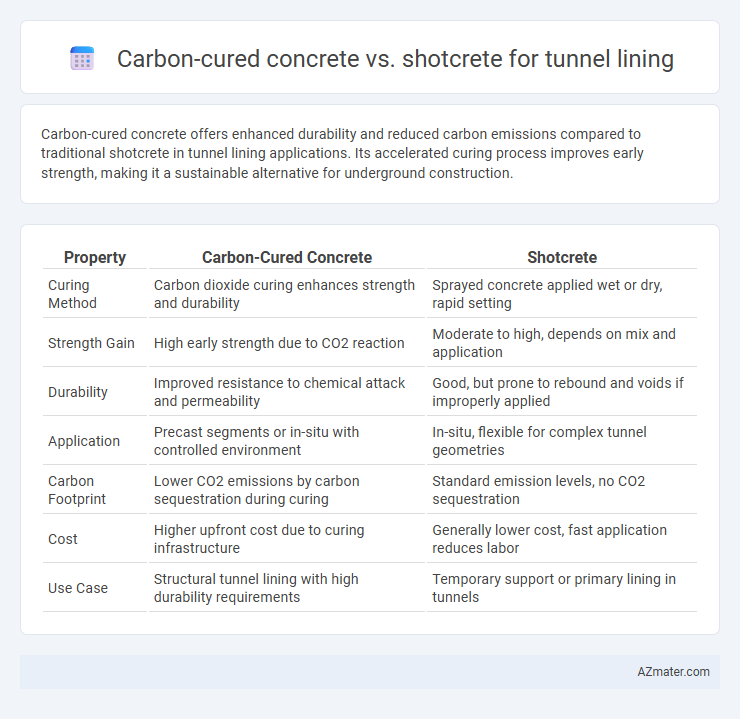Carbon-cured concrete offers enhanced durability and reduced carbon emissions compared to traditional shotcrete in tunnel lining applications. Its accelerated curing process improves early strength, making it a sustainable alternative for underground construction.
Table of Comparison
| Property | Carbon-Cured Concrete | Shotcrete |
|---|---|---|
| Curing Method | Carbon dioxide curing enhances strength and durability | Sprayed concrete applied wet or dry, rapid setting |
| Strength Gain | High early strength due to CO2 reaction | Moderate to high, depends on mix and application |
| Durability | Improved resistance to chemical attack and permeability | Good, but prone to rebound and voids if improperly applied |
| Application | Precast segments or in-situ with controlled environment | In-situ, flexible for complex tunnel geometries |
| Carbon Footprint | Lower CO2 emissions by carbon sequestration during curing | Standard emission levels, no CO2 sequestration |
| Cost | Higher upfront cost due to curing infrastructure | Generally lower cost, fast application reduces labor |
| Use Case | Structural tunnel lining with high durability requirements | Temporary support or primary lining in tunnels |
Introduction to Tunnel Lining Methods
Tunnel lining methods primarily include carbon-cured concrete and shotcrete, both pivotal for structural stability and waterproofing. Carbon-cured concrete leverages accelerated curing via CO2 injection, enhancing durability and reducing carbon footprint in tunnel applications. Shotcrete, a pneumatically projected concrete, offers versatility and rapid application on irregular surfaces, making it suitable for complex tunnel geometries and immediate support.
Overview of Carbon-Cured Concrete
Carbon-cured concrete is a cutting-edge technology that enhances tunnel lining durability by injecting carbon dioxide during the curing process to improve strength and reduce permeability. This method accelerates the carbonation process, resulting in a denser microstructure and increased resistance to chemical attacks and environmental degradation. Unlike Shotcrete, which is sprayed concrete applied in layers, carbon-cured concrete offers better long-term performance and sustainability through significant CO2 sequestration.
What is Shotcrete?
Shotcrete is a method of applying concrete projected at high velocity onto surfaces, commonly used for tunnel lining due to its rapid application and strong adhesion. Unlike carbon-cured concrete, which uses carbon dioxide for accelerated curing and enhanced durability, shotcrete is typically sprayed in layers to conform to irregular tunnel shapes, providing immediate structural support. Its versatility and quick setting time make shotcrete a preferred choice for complex tunnel geometries and environmentally challenging conditions.
Key Material Properties Comparison
Carbon-cured concrete offers enhanced durability and reduced permeability compared to shotcrete, resulting in superior resistance to chemical attacks and long-term environmental effects. Shotcrete provides rapid application and excellent adhesion properties, crucial for immediate structural support in tunnel lining projects. The high compressive strength and improved density of carbon-cured concrete contribute to increased longevity, while shotcrete's flexibility and ease of placement allow for efficient reinforcement in complex tunnel geometries.
Installation Techniques and Equipment
Carbon-cured concrete tunnel linings utilize specialized curing chambers that accelerate carbon sequestration, requiring precise environmental controls and carbon dioxide injection systems to enhance strength and durability. Shotcrete application involves pneumatically spraying concrete at high velocity through a nozzle, using robotic arms or manual setups, enabling rapid placement and excellent adhesion to irregular tunnel surfaces. Installation equipment for carbon-cured concrete includes containment vessels and CO2 distribution networks, whereas shotcrete relies on high-pressure pumps, compressors, and nozzle assemblies for flexible and efficient tunnel lining construction.
Durability and Longevity
Carbon-cured concrete exhibits enhanced durability due to its accelerated carbonation process, which increases surface hardness and reduces permeability, making it particularly resistant to chemical attack and environmental degradation in tunnel linings. Shotcrete provides high early strength and excellent adhesion to complex tunnel geometries but may require additional waterproofing measures to ensure long-term durability against moisture ingress and freeze-thaw cycles. For tunnel lining longevity, carbon-cured concrete offers superior resistance to micro-cracking and corrosion of reinforcement, significantly extending service life compared to traditional shotcrete applications.
Environmental Impact and Sustainability
Carbon-cured concrete significantly reduces carbon dioxide emissions by capturing CO2 during the curing process, enhancing tunnel lining sustainability through permanent carbon sequestration. Shotcrete, while flexible and quick to apply in tunnel lining, typically relies on traditional cement with higher embodied carbon, resulting in greater environmental impact. Prioritizing carbon-cured concrete promotes lower carbon footprints and aligns with green construction standards for sustainable tunnel infrastructure.
Cost and Economic Considerations
Carbon-cured concrete offers cost advantages for tunnel lining by reducing curing time and improving early strength, which accelerates construction schedules and lowers labor expenses. Shotcrete, while flexible and suitable for complex geometries, often incurs higher material and operational costs due to the need for specialized equipment and skilled labor. Evaluating life-cycle costs, carbon-cured concrete generally provides better economic efficiency in projects prioritizing rapid turnaround and reduced downtime.
Real-World Applications and Case Studies
Carbon-cured concrete offers enhanced durability and reduced curing times in tunnel lining applications, as demonstrated by projects like the Gotthard Base Tunnel in Switzerland, where faster setting reduced construction delays. Shotcrete remains preferred for irregular rock surfaces and complex geometries in tunnels such as New York City Subway expansions, providing superior adhesion and flexibility. Comparative studies reveal carbon-cured concrete excels in controlled environments with high precast element usage, while shotcrete dominates in situ adaptations requiring immediate structural support.
Choosing the Right Tunnel Lining Solution
Carbon-cured concrete offers enhanced durability and faster curing times compared to traditional shotcrete, making it ideal for tunnel linings requiring quick strength gain and long-term corrosion resistance. Shotcrete remains a versatile solution with efficient application in complex tunnel geometries and rapid placement, favored for smaller projects or repairs. Selecting between carbon-cured concrete and shotcrete depends on project scale, environmental conditions, structural requirements, and desired longevity, with carbon-cured concrete excelling in sustainable, high-performance tunnel linings.

Infographic: Carbon-cured concrete vs Shotcrete for Tunnel lining
 azmater.com
azmater.com